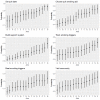Optimizing Text Messages to Promote Engagement With Internet Smoking Cessation Treatment: Results From a Factorial Screening Experiment
- PMID: 32238338
- PMCID: PMC7386536
- DOI: 10.2196/17734
Optimizing Text Messages to Promote Engagement With Internet Smoking Cessation Treatment: Results From a Factorial Screening Experiment
Erratum in
-
Correction: Optimizing Text Messages to Promote Engagement With Internet Smoking Cessation Treatment: Results From a Factorial Screening Experiment.J Med Internet Res. 2020 Jul 28;22(7):e21027. doi: 10.2196/21027. J Med Internet Res. 2020. PMID: 32721924 Free PMC article.
Abstract
Background: Smoking remains a leading cause of preventable death and illness. Internet interventions for smoking cessation have the potential to significantly impact public health, given their broad reach and proven effectiveness. Given the dose-response association between engagement and behavior change, identifying strategies to promote engagement is a priority across digital health interventions. Text messaging is a proven smoking cessation treatment modality and a powerful strategy to increase intervention engagement in other areas of health, but it has not been tested as an engagement strategy for a digital cessation intervention.
Objective: This study examined the impact of 4 experimental text message design factors on adult smokers' engagement with an internet smoking cessation program.
Methods: We conducted a 2×2×2×2 full factorial screening experiment wherein 864 participants were randomized to 1 of 16 experimental conditions after registering with a free internet smoking cessation program and enrolling in its automated text message program. Experimental factors were personalization (on/off), integration between the web and text message platforms (on/off), dynamic tailoring of intervention content based on user engagement (on/off), and message intensity (tapered vs abrupt drop-off). Primary outcomes were 3-month measures of engagement (ie, page views, time on site, and return visits to the website) as well as use of 6 interactive features of the internet program. All metrics were automatically tracked; there were no missing data.
Results: Main effects were detected for integration and dynamic tailoring. Integration significantly increased interactive feature use by participants, whereas dynamic tailoring increased the number of features used and page views. No main effects were found for message intensity or personalization alone, although several synergistic interactions with other experimental features were observed. Synergistic effects, when all experimental factors were active, resulted in the highest rates of interactive feature use and the greatest proportion of participants at high levels of engagement. Measured in terms of standardized mean differences (SMDs), effects on interactive feature use were highest for Build Support System (SMD 0.56; 95% CI 0.27 to 0.81), Choose Quit Smoking Aid (SMD 0.38; 95% CI 0.10 to 0.66), and Track Smoking Triggers (SMD 0.33; 95% CI 0.05 to 0.61). Among the engagement metrics, the largest effects were on overall feature utilization (SMD 0.33; 95% CI 0.06 to 0.59) and time on site (SMD 0.29; 95% CI 0.01 to 0.57). As no SMD >0.30 was observed for main effects on any outcome, results suggest that for some outcomes, the combined intervention was stronger than individual factors alone.
Conclusions: This factorial experiment demonstrates the effectiveness of text messaging as a strategy to increase engagement with an internet smoking cessation intervention, resulting in greater overall intervention dose and greater exposure to the core components of tobacco dependence treatment that can promote abstinence.
Trial registration: ClinicalTrials.gov NCT02585206; https://clinicaltrials.gov/ct2/show/NCT02585206.
International registered report identifier (irrid): RR2-10.1136/bmjopen-2015-010687.
Keywords: internet; smoking cessation; text messaging; tobacco dependence.
©Amanda L L Graham, George D Papandonatos, Megan A Jacobs, Michael S Amato, Sarah Cha, Amy M Cohn, Lorien C Abroms, Robyn Whittaker. Originally published in the Journal of Medical Internet Research (http://www.jmir.org), 02.04.2020.
Conflict of interest statement
Conflicts of Interest: AG, MJ, MA, and SC are employees of Truth Initiative, a nonprofit public health foundation, which sells enterprise digital tobacco cessation programs to support its mission-driven work. All other authors declare no conflicts of interest.
Figures
References
-
- Pew Research Center. 2019. Jun 12, [2020-03-09]. Internet/Broadband Fact Sheet, 2019 http://www.pewinternet.org/fact-sheet/internet-broadband/
-
- Graham AL, Amato MS. Twelve million smokers look online for smoking cessation help annually: health information national trends survey data, 2005-2017. Nicotine Tob Res. 2019 Jan 4;21(2):249–52. doi: 10.1093/ntr/nty043. http://europepmc.org/abstract/MED/29660037 - DOI - PMC - PubMed
-
- McCausland K, Curry L, Mushro A, Carothers S, Xiao H, Vallone D. Promoting a Web-Based Smoking Cessation Intervention: Implications for Practice. Cases in Public Health Communication & Marketing. Proc. 2011;5:3–26.
-
- Rudie M, Bailey L. North American Quitline Consortium. 2018. [2020-03-09]. North American Quitline Consortium FY2018 Annual Survey: Progress Update on State Quitlines https://www.naquitline.org/resource/resmgr/2018_survey/NAQC_FY2018_Annua....
-
- Taylor GM, Dalili MN, Semwal M, Civljak M, Sheikh A, Car J. Internet-based interventions for smoking cessation. Cochrane Database Syst Rev. 2017 Sep 4;9:CD007078. doi: 10.1002/14651858.CD007078.pub5. http://europepmc.org/abstract/MED/28869775 - DOI - PMC - PubMed
Publication types
Associated data
Grants and funding
LinkOut - more resources
Full Text Sources
Medical
Research Materials
Miscellaneous



